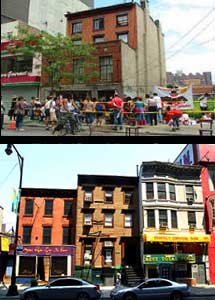
Forgotten New York has a great photo essay about Downtown Brooklyn. The page is titled "Albee Darned" (cute, huh?) and among many observations, it has this to say about Duffield Street:
The Duffield Street Houses, 182, 184, 186 and 188, just north of St. Boniface [pictured above], have been designated NYC landmarks since 2001. When Metrotech was constructed along part of Johnson Street (Tech Place) from 1989-1995 the houses were moved here. They were built by Johnson Street's namesake Samuel Johnson in the early 1800s.The site continues:
However: it strikes your webmaster as somewhat odd that 225, 231, 235, 223, 227 and 233 Duffield (see above), which have been on Duffield all along and are purported to have more history behind them, have not been so designated.
A group of buildings at 225, 231, 235, 223, 227 and 233 Duffield (shown at left) are believed to date to the Civil War era and are further believed by their owners to be former homes of abolitionists, if not stops on the Underground Railroad, as was the nearby 1846 First Free Congregational Church, later the African Wesleyan Methodist Episcopal Church on Bridge Street south of Johnson Street in MetroTech Center.
The city has plans to seize the houses via eminent domain, demolish most of the houses on this stretch of Duffield and replace them mostly with parking spaces, and further develop 500 new hotel rooms, 1,000 units of mixed income housing, more than 500,000 square feet of retail space and at least 125,000 square feet of new office space in the area.
The city’s Landmarks Preservation Commission (LPC) appears to be washing its hands of involvement with three endangered Duffield Street houses which are linked to the Underground Railroad and the anti-slavery movement in mid-19th century Brooklyn.
In a May 28th letter to Peg Breen, the president of the New York Landmarks Conservancy, LPC Commissioner Robert Tierney said, “Given the dramatic changes that will occur to the streetscape of Duffield Street, I believe the commemoration of the important role Brooklyn has played in the history of abolitionism will be better served by the program of memorialization referenced by EDC (the city’s Economic Development Corporation) and the City Council than by preserving the three buildings.” [Brooklyn Graphic]
We've seen the LPC's reluctance to get involved with altered yet historic buildings before.
The city hired consulting firm AKRF, which has conveniently failed to find any reason to preserve the houses.
A new city report has again cast doubt on claims by residents of Duffield Street that their Downtown Brooklyn houses were part of the Underground Railroad.
A city-hired consulting firm revealed this week that there is no conclusive evidence that seven houses on Duffield and Gold streets were part of the fabled fugitive slave network.
“It [the Duffield houses] ... does not have a significant association with a national figure of the Underground Railroad and his/her Underground Railroad activity,” the report concluded.
The report by AKRF, a consulting firm that researches historic claims, also refuted residents’ contention that the buildings were connected to known abolitionists.
“Of course they’re going to say that,” said Joy Chatel, the owner of 227 Duffield St. “They’re trying to whitewash the truth — that my house was part of the Underground Railroad, and that it was owned by known abolitionists.” [Brooklyn Paper]
There is a firm called AKRF which has 25 years experience in squelching opposition to big development projects. They recently undertook their longest venture in historical analysis: Two and a half years devoted to trying to deny the claims that Duffield Street in Downtown Brooklyn was part of the Underground Railroad of the Civil War era. They failed spectacularly. Abolitionists who walked the streets of Downtown Brooklyn would be proud. [Underground Railroad Safe Houses]
Oh, and here's a gratuitous additional photo from the Forgotten New York page:

